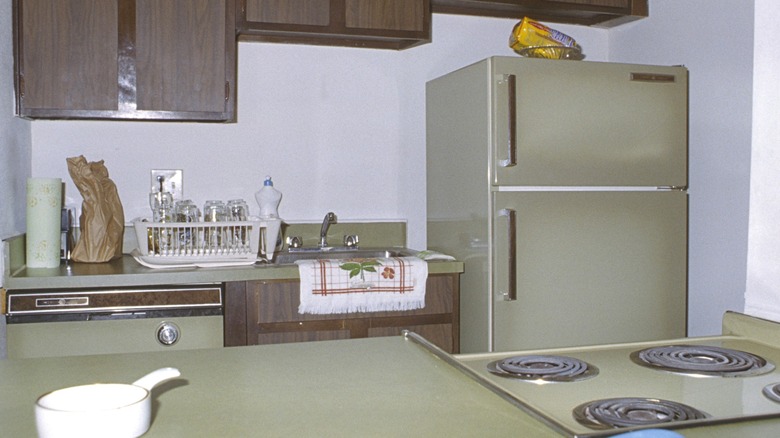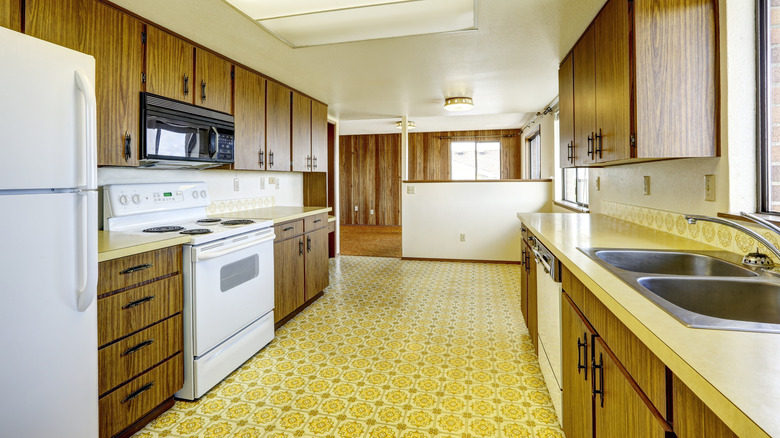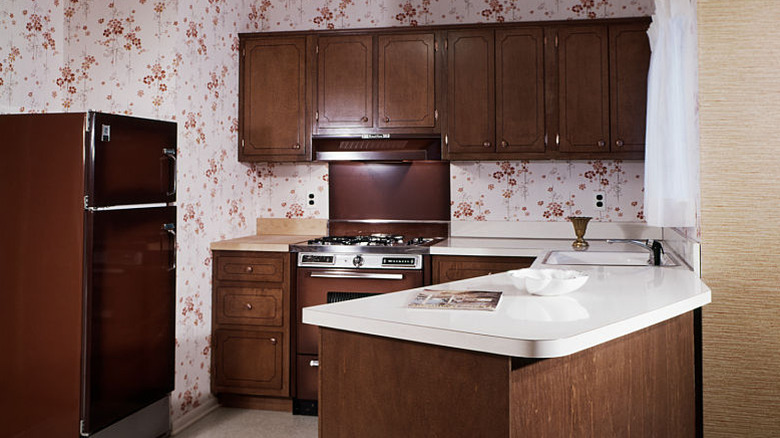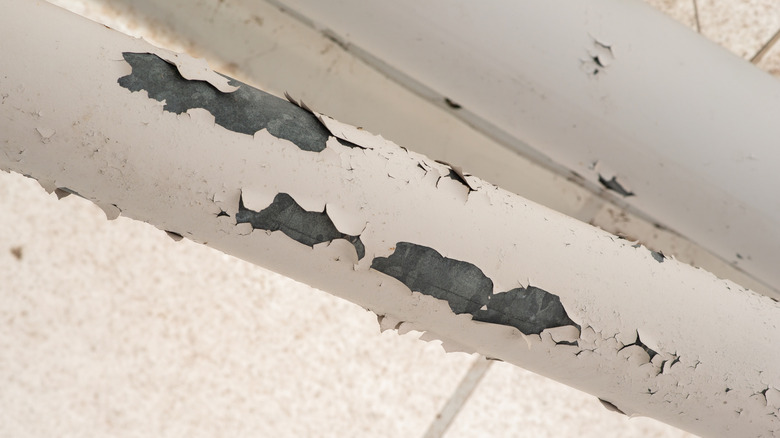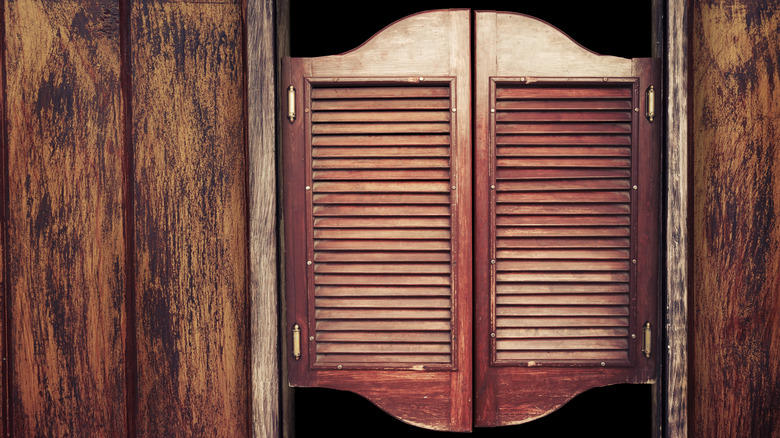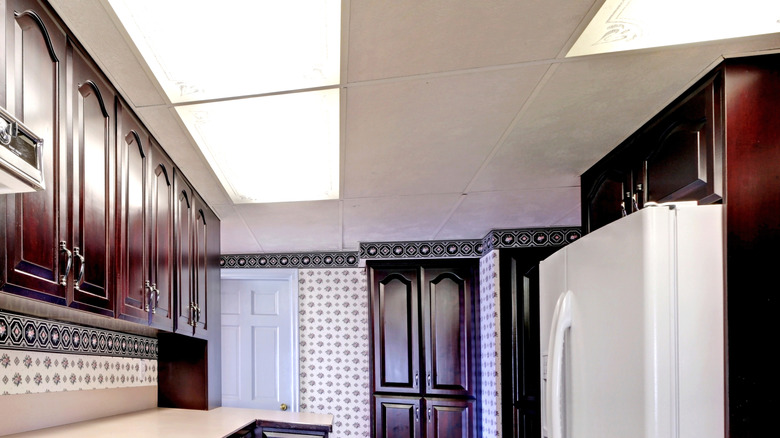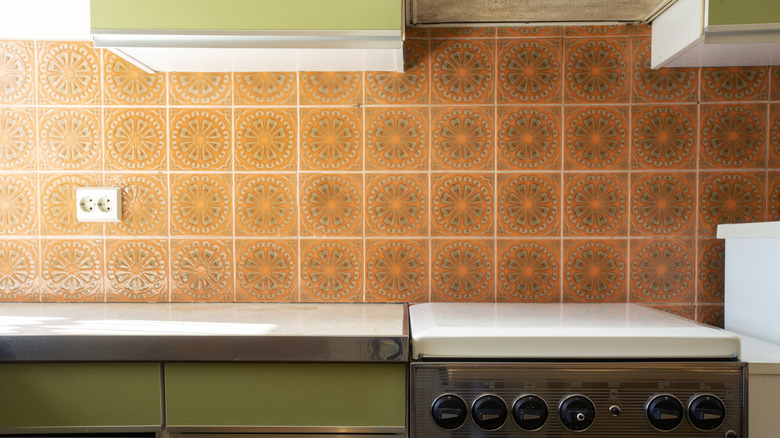The Worst Aspects Of A Dated '70s Kitchen
The 1970s were an interesting time for interior design, especially in the kitchen. If you were around during the era, you probably remember yellow flowered linoleum floors, wall-hung landlines with mile-long cords, and avocado-green everything. To be fair, there were a lot of good things as well. For one, the kitchen was still a place for socializing and the heart of the home. However, some of the worst aspects of '70s kitchens were not only about style but also function. Kitchens felt cluttered because they were closed off from the rest of the home, yet they still had an eating area, taking up valuable space. While Gen Z may be embracing many of the aesthetics from the era, those of us who remember the '70s think some trends are best left in the past. And many features of a 1970s kitchen can dramatically date your home and possibly even decrease its value.
The quickest way to make a room look dated is to incorporate elements that are too trendy. During the late '60s and throughout the 1970s, there were a variety of home design features that were trendy — brightly colored plastic furniture, wall-to-wall carpeting, and psychedelic colors everywhere. Most certainly, no one would argue that much of the '70s vibe was loud, colorful, and full of self-expression. We're not saying that's a bad thing — it just means that interior design from the '70s tends to look a lot more dated. While there are some retro kitchen essentials that we hope return, there are far more that we don't.
Avocado-green everything
Avocado green was the go-to color for interior design in the '70s, just barely nudging out harvest gold for the top spot. You could have your entire kitchen match with appliances, Formica countertops, and laminate flooring, all in this earthy shade of green. Millennials may have avocado toast, but their parents or grandparents probably had an avocado-colored toaster.
Mushroom motifs everwhere
You've probably noticed items showing up on Pinterest boards featuring colorful mushrooms. Ceramic canisters, mail sorters, and even cookware have been popping up on social media with mushroom motifs. This is a throwback to 1970s kitchen kitsch. During the era of disco, people were decorating their homes with forest fungi, and it was everywhere. It was most likely a nod to the previous decade with this cheeky domestic decor. You're bound to find it on backsplashes, drawer liners, and even wallpaper.
Floral wallpaper
To go with your avocado appliances was a loudly colored, floral wallpaper. The design was usually bright orange and yellow blossoms the size of your palms. You could never say that kitchens in the '70s weren't cheerful. Wallpaper in the kitchen soon fell out of style, replaced by less labor-intensive designs. Let's face it, painted walls were also a lot easier to clean than textured, fluorescent-colored wallpaper.
Colorful linoleum flooring
And the color theme of the 1970s kitchen wouldn't be complete without harvest-gold-colored linoleum flooring. The popular linoleum came in different floral or geometric designs. Another popular pattern was an interlocking small faux brick. In the '70s, rolled vinyl flooring was colorful, textured, and easy to clean. Just don't ask how it is for someone removing a 1970s kitchen floor.
Weird hardware placement
For some odd reason, it was the style to place hardware in the center of cupboard doors in the '70s. If you've ever been to the home of someone who still has cupboards like this, you know how awkward opening a cupboard with a center pull can feel. It was a conscious design choice of the era because there is nothing about pulls in the center of cupboard doors that enhances function. Retro kitchen cabinet colors are making a comeback, maybe a centered pull will join them as well.
Dark wood everywhere
Dark wood was part of the earthy, nature-based movement of the '70s, and it was everywhere. If you've ever been in the finished basement of a 1970s home, you most likely have seen your share of dark wood paneling. Well, the kitchen cabinets were also incorporated to embrace dark wood finishes. The only drawback for this design choice was that it tended to make the kitchen feel like a cave, unless there were some large windows to counterbalance it.
Bad layout
During the 1970s, most homes were designed around the traditional family of the period, which meant that the kitchen was designed with only one cook in mind. And signifying that most kitchens didn't focus on good workflow, which ended up creating dead zones. The kitchen of the '70s often had an eat-in nook or peninsula that took up precious space and often made the room feel claustrophobic as well as less functional.
Toxic materials
It's no secret that many materials used in past home construction and design contained toxic materials. Often, it was simply because people didn't know any better. By the 1970s, things were getting better, but there were still many items being used in homes that were unsafe. Asbestos was used to insulate wiring and the internal mechanisms of small appliances, like crockpots. Lead was still present in some paints or vinyl flooring. That's why if you own an older home, it's a good idea to get it checked.
Saloon doors
For some reason, homeowners in the 1970s also loved the saloon look and wanted their kitchen entry to look the part. The drawback to having saloon doors is that they were often louvered, which has a nice retro feel but can lose its appeal when cleaning time comes around. Notorious for collecting dust, when added to a kitchen, they will also attract grease, which makes for a sticky, grimy mess. If updated, louvered saloon doors can make your kitchen adorable. But the dark wood, slatted saloon doors should be left in the '70s.
Carpet in the kitchen
Carpets were everywhere in the 1960s and '70s. After decades of wood floors, many homeowners desired warmth and coziness, and so wall-to-wall carpeting became a thing. Probably the most controversial trend was carpet in the bathroom — and this atrocity lasted well into the '80s. But yes, there was even a time when carpet was installed in kitchens. Although not quite as bad as the bathroom, it had drawbacks. Not only was it unsanitary, but it was also challenging to clean.
Closed off from the home
While the main living areas of 1970s homes were moving toward a more open-concept style, the one room of the house that was still closed off was the kitchen. If you were lucky, your kitchen might have a pass-through window or a bar with cupboards. Most of the time, kitchens of this era were closed and could make a cook feel isolated during gatherings.
Formica countertops
Formica is actually the brand name of the most well-known laminate countertop manufacturer of the era. And laminate countertops were in almost every kitchen in the '70s. They were supposed to be more durable, easy to clean, and the height of style because they came in colors to match your decor. The problem is, not only was the adhesive used for these countertops most likely made with asbestos, but the laminate itself also contained high levels of lead (especially if it was a faux wood pattern). Putting that aside, they were also not very heat-resistant and often separated from the counter because of moisture issues.
Drop ceilings with fluorescent lighting
If you like feeling claustrophobic in your kitchen, then the drop ceiling/fluorescent lighting combo popular in the '70s should make you feel right at home. This trend became popular as a way to save on heating costs and hide damaged ceilings in older homes, and it continued into the 1980s. The low ceilings made you feel like you were cooking in a cave, and the harsh fluorescent lighting made it worse. Many homeowners, when remodeling these kitchens, opt to open up the space to the rest of the home.
Flashy tile backsplash
While this trend may stand out as a feature that some actually love, flashy tile backsplashes in the 1970s were very matchy-matchy. This could quickly create color overload for a homeowner. The tile backsplashes of the era were made to match the appliances, the countertops, the floral wallpaper, and the vinyl floor. Unfortunately, if your '70s kitchen has a backsplash that is a brightly patterned example of the era, it is definitely dating your kitchen.
Wood paneling
Wood paneling was everywhere in the home in the 1970s, to the point that not even the kitchen was safe. Whether it was a paneled wall or a peninsula wrapped in warm wood paneling, this trend was one more way to bring nature indoors. If you're remodeling a '70s kitchen, paneling should be on the list of what to remove because nothing dates a home faster than 1970s wood paneling. While the trend of wood paneling is seeing a resurgence, it is getting a much-needed style update.

